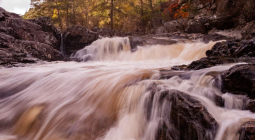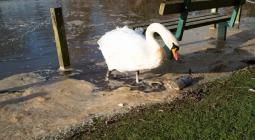Ankle deep in sewage’: English spring water village suffers suspected unlawful spills
Colwall, a village of less than 3,000 people on the border between Herefordshire and Worcestershire, is renowned for its spring water, which comes from the nearby Malvern Hills. An area of outstanding natural beauty, it has been favoured by the royal family for centuries, including Elizabeth I and Queen Victoria.
But the water at Colwall is now in the spotlight for very different reasons. The most recent data from Severn Trent Water, the company that covers the area, reveals that a sewage treatment works on Cradley Brook, near the village, spilled sewage for 1,756 hours in 2021 and 1,361 hours in 2022.
An analysis by the campaign group Windrush Against Sewage Pollution suggests some of these spills may be in breach of the water firm’s environmental permits. Its analysis suggests there were 72 unlawful spills in 2021 and 2022. Severn Trent said this weekend the “desktop” analysis was based on certain assumptions, and insisted the works were operating in line with permit conditions.
Chris Blake, a member of the Colwall Orchard Group, a volunteer group that grows apples for the community, says that nature was a formative part of his childhood in Herefordshire, and worries it is now being tainted by pollution.
“I remember playing in the shallows: you could look into the water, it was crystal clear and you could see the weeds streaming away down the river,” he said.
But the beauty he enjoyed as a child, both in the smaller brooks and larger rivers, has since been lost, he said. “The water doesn’t look wonderful. We would look across the rapids where the salmon fishermen were. Now there’s no fishermen because there’s no salmon.”
In April, a blockage in a pipe at Colwall led to sewage streaming into the roads and fields, with the discharges up to a foot deep in some places. Severn Trent said a third party had put plastic balls into the sewer, causing the spill.
A major concern among Colwall’s residents is the inability of the current sewage treatment plant – already struggling to deal with the village’s population – to cope with a planned new housing development that was voted against by about 92% of residents. It was given planning permission earlier this year.
Paul Evans, a local resident, has been lobbying the local council for years to investigate the Severn Trent sewage infrastructure and whether it is adequate for a growing population.
In a submission to the local council in opposition to the development of 36 new homes, he wrote: “We know that [the sewage treatment works] is already dumping raw sewage into Cradley Brook on a regular basis and Old Colwall was left ankle deep in sewage earlier this year because of a pipeline failure. Does anyone believe it is right to permit this development to exacerbate these problems?”
Severn Trent was awarded the top four-star rating in its most recent annual environmental performance assessment by the Environment Agency. The firm achieved the highest rating despite paying a £2m fine in February for “reckless” pollution of the River Trent.
A Severn Trent spokesperson said: “The treatment works is operating normally in line with all its permits. The storm overflow is affected by increased rainfall but due to local interventions, spill numbers are being actively reduced.”
Helen Heathfield, a councillor at Herefordshire council, regularly tests water in Cradley Brook. She says the tests have found “worrying” levels of phosphate, with contributing factors including agricultural run-off and sewage discharges.
She said that the nationalisation of water companies is the only way to guarantee that the quality of local water is held accountable by the people who drink it. “Colwall is a really beautiful, lovely place and the people who live there are very lucky – it’s heartbreaking that we’re letting this happen.”
Cover photo: By The Guardian




